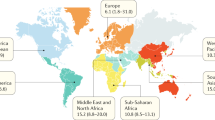Abstract
Objective:
To establish the reproducibility of a published observation by Lubetzky et al. that infants affected by retinopathy of prematurity (ROP) had higher absolute nucleated red blood cell (aNRBC) counts than those unaffected. The authors suggested that infants exposed to intrauterine hypoxia are at higher risk for ROP. We attempted to verify this reported relationship of ROP with the aNRBCs at birth and hypothesized that infants with ROP⩾ stage 2 have higher aNRBCs at birth.
Study Design:
We report a retrospective 1:1 case matched analysis where cases had a diagnosis of grade II ROP or worse and matching infants had confirmed stage I or no ROP. Eligible infants had birth weights of 501 to 1500 g and were discharged alive from 1st January 2000 to 31st December 2008. Wilcoxon's signed rank test was performed for continuous comparisons. This study was approved by two local Institutional Review Boards.
Result:
In all, 66 matched pairs were analyzed. When comparing aNRBCs there was no statistically significant relationship (w=−0.265, P=0.791) between the ROP affected group (M=4550, s.d.=7342) and the unaffected group (M=5287, s.d.=6524).
Conclusion:
We are unable to support the previously reported relationship of aNRBCs with ROP. Our population was three times larger, had higher aNRBCs and less retinopathy than previously reported. A biological principle of cause and effect or predisposition to ROP as reflected by aNRBCs should have been easier for us to demonstrate, if it existed.
This is a preview of subscription content, access via your institution
Access options
Subscribe to this journal
Receive 12 print issues and online access
$259.00 per year
only $21.58 per issue
Buy this article
- Purchase on Springer Link
- Instant access to full article PDF
Prices may be subject to local taxes which are calculated during checkout


Similar content being viewed by others
References
Lubetzky R, Stolovitz C, Dollberg S, Mimouni FB, Salomon M, Mandel D . Nucleated red blood cells in preterm infants with retinopathy of prematurity. Pediatrics 2005; 116: 619–622.
Mccolm JR, Fleck BW . Retinopathy of prematurity: causation. Semin Neonatol 2001; 6: 453–460.
Silverman WA . Retrolental Fibroplasia: A Modern Parable. Grune and Stratton: New York, NY, 1980.
Kim TI, Sohn J, Pi SY, Yoon YH . Postnatal risk factors of retinopathy of prematurity. Paediatr Perinat Epidemiol 2004; 18: 130–134.
Smith LE . Pathogenesis of retinopathy of prematurity. Semin Neonatol 2003; 8: 469–473.
Seiberth V, Linderkamp O . Risk factors in retinopathy of prematurity. a multivariate statistical analysis. Ophthalmologica 2000; 214: 131.
Hagadorn JI, Richardson DK, Schmid CH, Cole CH . Cumulative illness severity and progression from moderate to severe retinopathy of prematurity. J Perinatol 2007; 27: 502.
Minior VK, Bernstein PS, Divon MY . Nucleated red blood cells in growth-restricted fetuses: associations with short-term neonatal outcome. Fetal Diagn Ther 2000; 15: 165–169.
Finne PH . Erythropoietin levels in cord blood as an indicator of intrauterine hypoxia. Acta Paediatr Scand 1966; 55: 478–489.
Vatansever U, Acunas B, Demir M, Karasalihoglu S, Ekuklu G, Ener S et al. Nucleated red blood cell counts and erythropoietin levels in high-risk neonates. Pediatr Int 2002; 44: 590–595.
Korst LM, Phelan JP, Ahn MO, Martin GI . Nucleated red blood cells: an update on the marker for fetal asphyxia. Am J Obstet Gynecol 1996; 175: 843–846.
Hermansen MC . Nucleated red blood cells in the fetus and new born. Arch Dis Child Fetal Neonatal Ed 2001; 84: 211–215.
An International Committee for the Classification of Retinopathy of Prematurity. Arch Ophthalmol 2005; 123: 991.
Policy statement: Section on Ophthalmology American Academy of Pediatrics American Academy of Ophthalmology American Association for Pediatric Ophthalmology and Strabismus. Pediatrics 2001; 108: 809.
Author information
Authors and Affiliations
Corresponding author
Ethics declarations
Competing interests
The authors declare no conflict of interest.
Rights and permissions
About this article
Cite this article
Gotru, S., Ahlers-Schmidt, C., Delmore, P. et al. The absolute nucleated red blood cell (aNRBC) count at birth is not an indicator for retinopathy of prematurity (ROP). J Perinatol 33, 21–24 (2013). https://doi.org/10.1038/jp.2012.34
Received:
Accepted:
Published:
Issue Date:
DOI: https://doi.org/10.1038/jp.2012.34
Keywords
This article is cited by
-
Absolute nucleated red blood cell count and retinopathy of prematurity (ROP)
Journal of Perinatology (2013)



